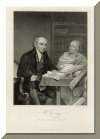
Memories of the Baptist Mission Press
by Ronald Ellis
My Father, Bernard
Ellis, Superintendent, Baptist Mission Press
Although he was a missionary, by training he
was a journalist. His father, grandfather, and brother were printers; and by
force of circumstance, he was a business man. His preoccupation was running the press
on ethical lines and as a thriving business. His notes reflect what it was like
to run a business in India rather than thoughts on religious
lines. He was quick to spot amusing situations
and had an English sense of humor.
The subjects he printed and the customers he had were not very different to
those the Press had in the early nineteenth century. The notes give a
flavor of what it must have been like for Carey, Ward, and Marshman. India does
not change that much. Right up to the 1950s and 1960s, the life of an Englishman
in India was fairly similar.
I have a typed autobiography of my
father, and exercise books my father filled with
reminiscences while in retirement in Bath.
There is also a Hindi New Testament with an imprint of 1955 and a catalogue
entitled "The Carey Exhibition of Early Printing and Fine Printing at the
National Library Calcutta" dated 1955, but not printed at BMP.
That is all my father kept from the Press.
Letterpress
Printing
Baptist Mission Press was a letterpress printers. That means the process was
still basically the same as that used by Gutenburg and Caxton. It requires
great skill to take metal type, ink it, and transfer the image onto paper. A lot
of type was set by hand compositors, working back to front, placing individual
pieces of type, spacers and leading to fill out the metal
forms ready for printing. One loose piece of type and the whole thing could
fall out of the frame and take days to put back into the composing cases. Never
mind resetting it all. I do not think that happened very much as everyone knew
the consequences.
The typesetting process was mechanized by the Linotype machine, which, by typing
the copy on a keyboard, a whole line of type was set at one time. This is how
newspapers were produced and was used at the Press for everyday jobs that did not
need fine printing. The type was melted down after use.
The Monotype machine
set every character and every space individually. The copy
was keyed onto punched tape. The tape was then sent through an automated setting
machine and this was used for high quality printing such as Bibles. The type
was also melted down after use.
All three processes went on side by side.
In the 1960s and 1970s, Letterpress printing was being replaced by Litho
printing which is a completely different process. It relies on the fact that
oil repels water and a whole book can be etched photographically onto a series
of
metal sheets. It is much quicker, cheaper, and easier to print in this way
which may be one of the reasons for the Press's demise. All the equipment
would have had to be replaced and a whole lot of new skills learned.
The Baptist Mission Press "Selling Brochure" (ca. 1930)
I found a selling brochure in my father's possessions when he died in 1985. I had never seen it before, but it explains the history of the Press and the sort of work it did. The illustration looks as if it was done around the time of the drawing. The front of the house is the same, as is the sign over the gate. The buildings behind would have been in existence when your drawing was done. The selling brochure, I am sure, was designed by my uncle, Norman Ellis, probably in the 1930s, as he was a keen and skilled typographer.
Click on these links to view the "Selling Brochure"
Cover Page 1 Page 2 Page 3 Page 4 Page 5 Page 6 Page 7 Page 8 Page 9
Created: October 22, 2002 Updated: November 6, 2002